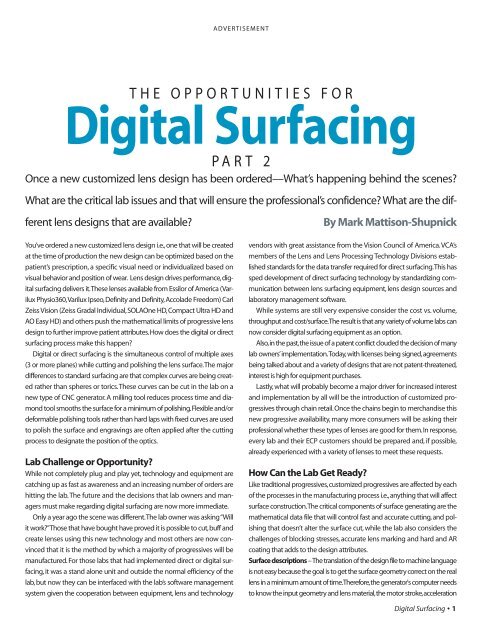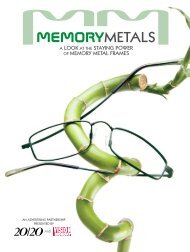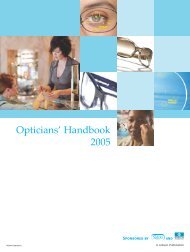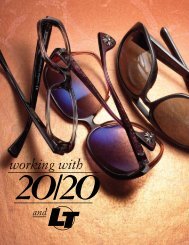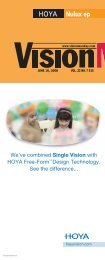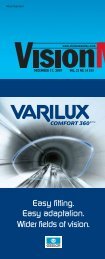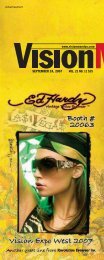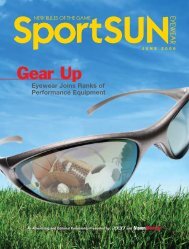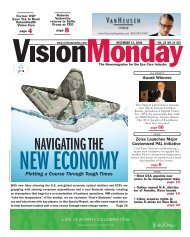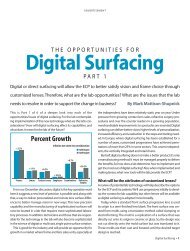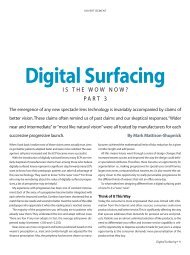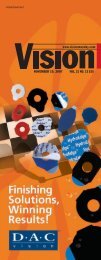The Opportunities For Digital Surfacing - Part 2
The Opportunities For Digital Surfacing - Part 2
The Opportunities For Digital Surfacing - Part 2
Create successful ePaper yourself
Turn your PDF publications into a flip-book with our unique Google optimized e-Paper software.
ADVERTISEMENT<br />
THE OPPORTUNITIES FOR<br />
<strong>Digital</strong> <strong>Surfacing</strong><br />
PART 2<br />
Once a new customized lens design has been ordered—What’s happening behind the scenes<br />
What are the critical lab issues and that will ensure the professional’s confidence What are the different<br />
lens designs that are available<br />
You’ve ordered a new customized lens design i.e.,one that will be created<br />
at the time of production the new design can be optimized based on the<br />
patient’s prescription, a specific visual need or individualized based on<br />
visual behavior and position of wear. Lens design drives performance,digital<br />
surfacing delivers it.<strong>The</strong>se lenses available from Essilor of America (Varilux<br />
Physio360,Varilux Ipseo,Definity and Definity,Accolade Freedom) Carl<br />
Zeiss Vision (Zeiss Gradal Individual,SOLAOne HD,Compact Ultra HD and<br />
AO Easy HD) and others push the mathematical limits of progressive lens<br />
design to further improve patient attributes.How does the digital or direct<br />
surfacing process make this happen<br />
<strong>Digital</strong> or direct surfacing is the simultaneous control of multiple axes<br />
(3 or more planes) while cutting and polishing the lens surface.<strong>The</strong> major<br />
differences to standard surfacing are that complex curves are being created<br />
rather than spheres or torics.<strong>The</strong>se curves can be cut in the lab on a<br />
new type of CNC generator. A milling tool reduces process time and diamond<br />
tool smooths the surface for a minimum of polishing.Flexible and/or<br />
deformable polishing tools rather than hard laps with fixed curves are used<br />
to polish the surface and engravings are often applied after the cutting<br />
process to designate the position of the optics.<br />
Lab Challenge or Opportunity<br />
While not completely plug and play yet, technology and equipment are<br />
catching up as fast as awareness and an increasing number of orders are<br />
hitting the lab. <strong>The</strong> future and the decisions that lab owners and managers<br />
must make regarding digital surfacing are now more immediate.<br />
Only a year ago the scene was different.<strong>The</strong> lab owner was asking “Will<br />
it work”Those that have bought have proved it is possible to cut,buff and<br />
create lenses using this new technology and most others are now convinced<br />
that it is the method by which a majority of progressives will be<br />
manufactured. <strong>For</strong> those labs that had implemented direct or digital surfacing,<br />
it was a stand alone unit and outside the normal efficiency of the<br />
lab, but now they can be interfaced with the lab’s software management<br />
system given the cooperation between equipment, lens and technology<br />
By Mark Mattison-Shupnick<br />
vendors with great assistance from the Vision Council of America.VCA’s<br />
members of the Lens and Lens Processing Technology Divisions established<br />
standards for the data transfer required for direct surfacing.This has<br />
sped development of direct surfacing technology by standardizing communication<br />
between lens surfacing equipment, lens design sources and<br />
laboratory management software.<br />
While systems are still very expensive consider the cost vs. volume,<br />
throughput and cost/surface.<strong>The</strong> result is that any variety of volume labs can<br />
now consider digital surfacing equipment as an option.<br />
Also,in the past,the issue of a patent conflict clouded the decision of many<br />
lab owners’implementation.Today, with licenses being signed, agreements<br />
being talked about and a variety of designs that are not patent-threatened,<br />
interest is high for equipment purchases.<br />
Lastly, what will probably become a major driver for increased interest<br />
and implementation by all will be the introduction of customized progressives<br />
through chain retail.Once the chains begin to merchandise this<br />
new progressive availability, many more consumers will be asking their<br />
professional whether these types of lenses are good for them.In response,<br />
every lab and their ECP customers should be prepared and, if possible,<br />
already experienced with a variety of lenses to meet these requests.<br />
How Can the Lab Get Ready<br />
Like traditional progressives,customized progressives are affected by each<br />
of the processes in the manufacturing process i.e.,anything that will affect<br />
surface construction.<strong>The</strong> critical components of surface generating are the<br />
mathematical data file that will control fast and accurate cutting, and polishing<br />
that doesn’t alter the surface cut, while the lab also considers the<br />
challenges of blocking stresses, accurate lens marking and hard and AR<br />
coating that adds to the design attributes.<br />
Surface descriptions – <strong>The</strong> translation of the design file to machine language<br />
is not easy because the goal is to get the surface geometry correct on the real<br />
lens in a minimum amount of time.<strong>The</strong>refore,the generator's computer needs<br />
to know the input geometry and lens material,the motor stroke,acceleration<br />
<strong>Digital</strong> <strong>Surfacing</strong> •1
ADVERTISEMENT<br />
and jerk behavior in order to calculate the<br />
optimal feed rate for each individual lens.<br />
Once the designs are available to labs, the<br />
assumption must be made that the designer<br />
has confirmed that the design corrects eyesight<br />
in the way intended.<br />
Manufacturers have begun to license their<br />
design files through programs where they<br />
will assist in the correct transfer of the design through the lab for delivery to<br />
the ECP.<br />
<strong>For</strong> example, Essilor has begun <strong>Digital</strong> <strong>Surfacing</strong> Extended Offering<br />
(DEO). Beginning third quarter, the first independent laboratory will offer<br />
Varilux 360° as part of a turnkey package. With equipment specified by<br />
Essilor and with software to download instructions from an Essilor server,<br />
the designs will be transferred to the lab for manufacture.To ensure accuracy<br />
of design and patient satisfaction,sample control lenses are sent daily<br />
to Essilor for analysis and verification. Adjustments can be made in real<br />
time.To complete the delivery of premium vision in design, Crizal Alizé is<br />
also available to these labs.<br />
Process Integration – Like the doctor’s office that purchases a variety of<br />
instruments and then needs to add the test data to the patient’s record<br />
as part of an electronic medical record,instrument software is required to<br />
“talk”to practice management systems to increase office efficiency. Why<br />
enter patient name and data multiple times in an electronic record when<br />
an integration of the systems can do it <strong>The</strong> same is now possible for the<br />
lab so that electronic data systems transfer machine-operating instructions<br />
for the Rx needed by any bar coded tray.<br />
Who’s on board Visionstar,CC Systems and <strong>Digital</strong> Vision lab management<br />
systems support “connectivity”with some of the generator companies.<br />
Be sure to review system capability and implementation of the VCA<br />
communication protocol.<br />
Implementation – Each lab should expect the same learning curve when<br />
installing new equipment and new software digital surfacing with one<br />
major difference. When installing direct or digital surfacing, one should<br />
expect a higher level of support from the lens design source, lab management<br />
software company and equipment supplier since the integration<br />
of these tools is essential for success.In fact,<br />
it is the responsibility of the lens design source<br />
to initially ensure that the design is correct since<br />
that’s the license being secured.<br />
Milling Characteristics – In the past, the lab<br />
had to determine the materials that were most<br />
often ordered when choosing equipment.<br />
Today,the digital surfacing generator is capable<br />
of cutting all materials and polishing requires adjustment depending on<br />
material. <strong>For</strong> example, the high utilization of polycarbonate in the U.S.<br />
affects machine efficiency.<strong>The</strong> Schneider HSC generator series incorporates<br />
three major changes for polycarbonate. First, the milling tool cuts<br />
short chips which are easier to clear from the chamber. Next, the cutting<br />
tool is positioned upside down to take advantage of gravity.And last,the<br />
work space is inclined to enhance swarf<br />
removal.<br />
Standard sphere and toric curves are cut by<br />
polycrystalline diamond (PCD),complex curves<br />
(progressives) require natural diamond for the<br />
smoothest surface.<br />
Surface Protection and Blocking – Blocking<br />
and surface protection is the same as it is for standard surfacing i.e., there<br />
are material stresses created by pressure and temperature, specific to lens<br />
material. <strong>For</strong> example, a lens whose front surface is spherical to start, after<br />
blocking and generating may be correct in design after cutting but once<br />
removed from the block, incorrect in design.This has been the same for<br />
standard progressives when blocking alloy has been too hot, lenses<br />
weren’t allowed to cool sufficiently before generating or too small a diameter<br />
block used.<strong>The</strong> surface “warps” and the corridor may have become<br />
unusable yet the distance and near values were correct. In addition, the<br />
blocking tolerances for digital surfacing are tighter.<br />
Centering of the Optic - <strong>For</strong> lenses with engravings on the front, exact centering<br />
is required without blocking errors that might make the optics drift in<br />
position. Some believe that engraving after the lens is manufactured is better,it<br />
marks what you have done,not what you would like to have done.<strong>The</strong><br />
other opportunity is to use digitally surfaced lenses that have front and back<br />
optics where a majority of the progressive surface is already on the front and<br />
the engravings have been applied to the mold prior to the casting process.<br />
Cutter Position and Data Feed – <strong>The</strong> maximum speed achieved for cutting<br />
with the precision required depends on the complexity of the surface. <strong>For</strong><br />
complex surfaces,the maximum stroke,acccelleration and jerk of the motor<br />
sets minimum processing time limits.<br />
Polishing – How has the more difficult<br />
polishing process been developed and<br />
what are the attributes of well-polished<br />
lenses <strong>The</strong> surface has been prepared<br />
to be as smooth and near transparent<br />
as possible,however,the fineness of cut<br />
is not yet possible to just allow a coating<br />
to complete the lens. As a result, a<br />
slight buffing or polish is required.<strong>The</strong><br />
Polishingconformable<br />
tools, variable<br />
paths.<br />
Twin tools,<br />
PCD and<br />
natural<br />
diamond.<br />
use of hard laps are not possible because those will destroy the surface shape,<br />
therefore soft and conformable tools have been developed to buff the surface.<strong>The</strong>y<br />
adjust to the shape of the surface.In addition,different tool radii are<br />
used to best match the surface curves generated.<br />
Special oscillation and polishing paths help ensure that the surface created<br />
is well polished.As a result,the software developed to guide lens path over the<br />
tool and the tools chosen are different for each lens surface.<strong>The</strong> equipment<br />
software and lab management software work together to understand which<br />
lens is being worked on so the correct polishing is completed.<br />
What Are the Economics<br />
<strong>For</strong> small labs, purchase is difficult.<strong>The</strong>re is the high capital outlay, from<br />
$500 thousand to $1 million dollars. Since the overall volume of digitally<br />
2• <strong>Digital</strong> <strong>Surfacing</strong>
ADVERTISEMENT<br />
surfaced lenses is still low,for many it is difficult to justify the expense.As a<br />
result, many small labs are waiting until there is more trial, use and<br />
increased demand by ECPs before they purchase their own equipment.<br />
In the meantime,however,many already provide digitally surfaced lenses<br />
through larger labs with which they have relationships or special digitally<br />
equipped labs that act as labs’ labs. Regardless, ECPs can get a variety of<br />
lenses from a good number of their suppliers.<br />
<strong>Digital</strong>ly surfaced lenses are available from many of the large and/or<br />
vertically integrated labs owned by lens manufacturers or large chains.<br />
<strong>For</strong> many of these companies, they have labs that are digitally capable<br />
in Europe and/or Asia and therefore have quite a bit of experience over<br />
the last 6-7 years. And, as we reported previously, customized progressives<br />
already account for 25 percent of the European progressive market<br />
in some sectors.<strong>The</strong>refore, this application is well defined in Europe but<br />
as yet not in the US market.<br />
What Happens to Standard Sphere<br />
And Toric Production<br />
Any lab can cut standard spheres and toric backs on fixed design, front surface<br />
progressives, whether or not they have been created using digital surfacing.<br />
However, customized designs will have the lenses with specially cut<br />
backs. <strong>For</strong> lenses like Physio360, the back surface creates sphere or cylinder<br />
power, axis and the optimization of front peripheral stigmatism. So the surface<br />
is no longer a traditional sphere or toric back.<br />
<strong>The</strong> same is true of Definity which incorporates a portion of the add power<br />
on the back surface of the lens along with the necessary sphere or cylinder<br />
powers.<strong>The</strong> combination of the surface is defined mathematically and cut and<br />
polished to deliver both.<strong>For</strong> Varilux Ipseo,SOLAOne HD and Compact Ultra HD,<br />
the prescription and progressive is cut onto the back surface, the front being<br />
spherical.In both lenses,the manufacturers assume an average vertex and tilt<br />
to calculate the lens powers.<strong>For</strong> the Zeiss Gradal Individual,the lens is personalized<br />
using vertex and tilt measurements from the actual fitting.<br />
In the future,a variety of lenses will require additional measurements for<br />
personalization and a variety of tools will be available.<strong>For</strong> example,Carl Zeiss<br />
Vision introduced Eye Terminal at Vision Expo East,an instrument designed<br />
for the ECP for accurate and repeatable lens measurements. More about<br />
these devices in the next issue.<br />
What Happens to “Base Curve”<br />
Lenses will still have a recommended base curve and manufacturers will continue<br />
to supply base curve charts for reference. However, the option exists<br />
for back surface progressives to use a larger variety of base curves for the<br />
same prescription when trying to match the curve cosmetics of frames. So<br />
a -2.00 lens could be designed on a 4 base or an 8 base curve if used in a<br />
standard shape or in a wrap frame respectively. <strong>For</strong> the wrap frame, the Rx,<br />
add and the effects of the wrap angle can be optimized for a 7 or 8 base so<br />
that the central power incorporates the prism needed for good binocularity<br />
and peripheral optics are more usable by optimization.<br />
If you have questions about a particular job; call your lab or the manufacturer<br />
for details and explanatory literature.<br />
What Should be the ECP’s Expectation of the Lab<br />
Labs will continue to be the ECP’s best resource for information and recommendations<br />
for patients’ lenses. As they get more experienced, they<br />
will share more of the experiences of their customers and their customers’<br />
“pearls”.<br />
Seek out those labs that have begun to offer digitally surfaced products<br />
for information and experiences—seek out peers that have begun to add<br />
digitally surfaced products to their portfolio of lenses.<strong>The</strong> overall reactions<br />
of the vast majority of patients and professionals trying the lenses are that<br />
they provide improved clarity of vision and a more comfortable wearing<br />
experience. <strong>For</strong> some it’s “wow,” for others the small improvements are<br />
noticeable and appreciated.<br />
Where’s the Liability of Design<br />
While there will be some variation,correctness of design now lies with the<br />
lens design originator and the producer of that design i.e., the lab supported<br />
by the design source. Of course, as in the standard supply chain,<br />
the ECP will hold the lab responsible, the lab will hold the manufacturer<br />
responsible, etc.<br />
How Does the Lab Ensure Equipment Calibration<br />
And Design Verification<br />
<strong>The</strong> lab will initially rely on the equipment supplier and their technicians for<br />
calibration and design verification until they are functional.Essilor will require<br />
audit lenses,others will create their own verification systems.Regardless,learn<br />
and understand how your source of digitally surfaced lenses ensures that the<br />
ECP receives the right product.<br />
<strong>For</strong> the lab, much of this new equipment is very robust i.e., self-calibrating<br />
with their own sets of controls and checks.New for the lab however,will<br />
be a requirement for increased knowledge about the technology.That will<br />
mean internal engineering staff capable of better understanding the integration<br />
of software with the technology of the equipment. In fact, this will<br />
open many new opportunities for lab staff as well as require the labs to<br />
source personnel with new skills.<strong>For</strong> some small labs,this may create some<br />
challenges.<br />
Some compare this shift to AR and its implementation in the lab. Like<br />
AR, the labs quickly embraced and began to offer products as they<br />
improved their capabilities.<strong>The</strong> difference here is that the manufacturer<br />
or source of the lens design is a partner with the lab.As a result,the power<br />
of the manufacturer and the reputation of their design require that they<br />
help ensure success.<br />
What Will the ECP do to Verify Lenses<br />
Lens verification for the ECP will be the same as it is now—verify distance and<br />
add power,fitting height and monocular PD’s well as base curve,lens materials<br />
and treatments.<strong>The</strong> rest is left up to the patient because the assumption is<br />
made that the design is correct.<br />
Since the manufacturers control the designs there should be audits of production<br />
and those that license designs have a responsibility to stop those<br />
products that don’t meet product design criteria.<br />
<strong>Digital</strong> <strong>Surfacing</strong> •3
ADVERTISEMENT<br />
Today, labs do not have the ability<br />
to check the design attributes of<br />
semi-finished progressives. Like the<br />
ECP, the only items that are checked<br />
are lensometer readings, fitting<br />
height and PD; the last two are based<br />
on an assumption that the markings<br />
represent the correct position for the<br />
patient.<strong>The</strong>re are many opportunities<br />
Auto tool adjustment, HSC Master<br />
to produce poor quality.<br />
<strong>The</strong>refore,there is a bigger responsibility for the ECP using digitally surfaced<br />
lenses i.e., better measurement techniques and better-trained staff to ensure<br />
increased success.A current progressive,traditionally surfaced with a standard<br />
method does not ensure that they are made to the patient’s requirements<br />
unless well measured and fit.<br />
Audits<br />
New techniques in the lab for design audit and equipment calibration will<br />
include such technologies as surface height reconstruction, Deflectometry<br />
and lens mapping by surface reflection.We’ll look at these techniques<br />
a bit closer in a later issue.<br />
Which Patients are the Right Targets,<br />
And How do You Talk to <strong>The</strong>m<br />
<strong>The</strong> right patient is the patient that wants the best in the category or has<br />
had some issues with the clarity of their existing progressives. How does<br />
the ECP understand the patient best suited for digitally surfaced progressives—talk<br />
to every patient about the newest technologies that provide<br />
the best vision and ask about the things that bother a patient when using<br />
their current progressives.In this way you uncover what a patient doesn’t<br />
like about their lenses, not merely replicate what they already have.<br />
Remember,as the prescription changes and as adds increase,progressive<br />
design changes.Adds get narrower or corridors are shortened based<br />
on small frame choice.<strong>The</strong>se new progressives improve all distance vision<br />
and in some, the design or corridor length is adjusted for frame size.<br />
Also, for the patient that expects the most precise correction and lens<br />
processing, digitally surfaced products add a new dimension to what is<br />
possible.<br />
New Since Last Article<br />
• <strong>The</strong> new optional Power Safety System (PSS) for the Schneider HSC<br />
Master generator reacts within micro seconds in the case of unexpected<br />
power failures eliminating the risk of machine damage.<strong>The</strong> system does<br />
not require a battery backup.<br />
• Carl Zeiss Vision introduced the Eye Terminal at Vision Expo East 2007,an<br />
imaging and measurement instrument designed for the precise fitting of<br />
direct or digitally surfaced HSC Master with PSS.<br />
lenses. Using sophisticated<br />
measuring technology; Eye<br />
Terminal automatically compiles<br />
monocular PD, fitting<br />
height, frame tilt (pantoscopic<br />
and wrap angles), and vertex<br />
distance.<strong>The</strong> imaging system<br />
allows patients to view<br />
themselves in their eyewear<br />
from all angles and learn about lens enhancements. It adds to the professional<br />
identity of any office.Remember,it’s the design that drives performance.<br />
Customized Progressives<br />
Lens Source Front Back<br />
Varilux Ipseo Essilor <strong>Digital</strong>ly molded <strong>Digital</strong>ly surfaced<br />
Varilux Physio360 Essilor <strong>Digital</strong>ly molded <strong>Digital</strong>ly surfaced<br />
Accolade Freedom Essilor <strong>Digital</strong>ly molded <strong>Digital</strong>ly surfaced<br />
Definity Essilor <strong>Digital</strong>ly molded <strong>Digital</strong>ly surfaced<br />
Definity short Essilor <strong>Digital</strong>ly molded <strong>Digital</strong>ly surfaced<br />
Zeiss Gradal Carl Zeiss Vision Spherical <strong>Digital</strong>ly surfaced<br />
Individual<br />
SOLAOne HD Carl Zeiss Vision Spherical <strong>Digital</strong>ly surfaced<br />
Compact Ultra HD Carl Zeiss Vision Spherical <strong>Digital</strong>ly surfaced<br />
AO Easy HD Carl Zeiss Vision Spherical <strong>Digital</strong>ly surfaced<br />
HOYAlux id HOYA <strong>Digital</strong>ly surfaced <strong>Digital</strong>ly surfaced<br />
Kodak Unique Signet Armorlite Spherical <strong>Digital</strong>ly surfaced<br />
EyeMade INDO, Spherical <strong>Digital</strong>ly surfaced<br />
Signet Armorlite<br />
Succeed SEIKO Pentax Spherical <strong>Digital</strong>ly surfaced<br />
Autograph Shamir Spherical <strong>Digital</strong>ly surfaced<br />
Questions Received, Comments Offered<br />
QIsn’t there a huge advantage to putting the Rx on the back surface<br />
combined with the progressive design<br />
ABy itself,moving the progressive to the back surface does not always<br />
improve the design. A progressive, a combination of front and back<br />
design,delivers the designer’s intent and depends on the way that an individual<br />
uses the lens. Some front surface designs can be shown to deliver<br />
the same or better characteristics depending on design and patient. Dual<br />
side progressives provide a designer with more room to reduce distortion<br />
and blur.However,in general,newer designs using higher precision to create<br />
molds or surfaces provide better vision,comfort and utility for wearers.<br />
Evolve patients to newer designs, they will appreciate the visual improvements.<br />
Sponsored by


